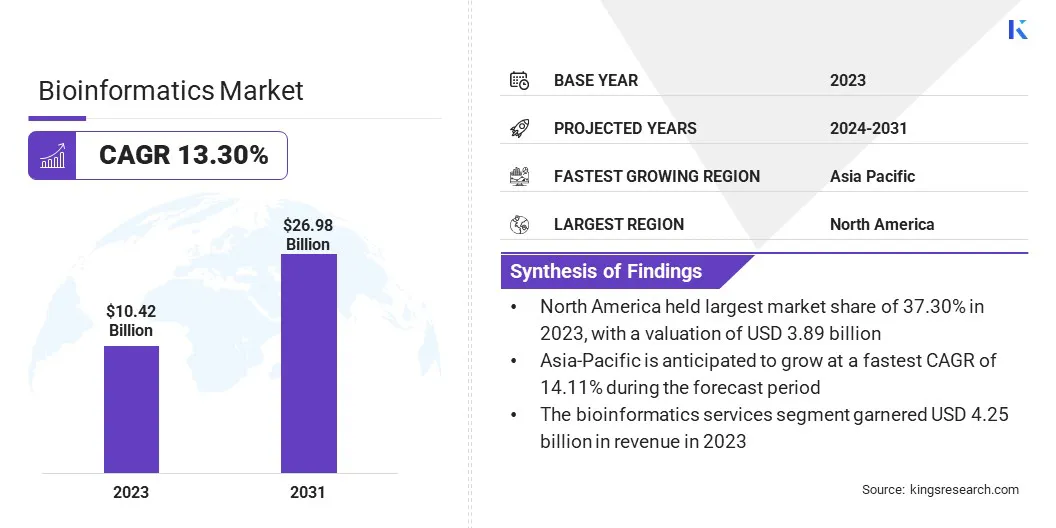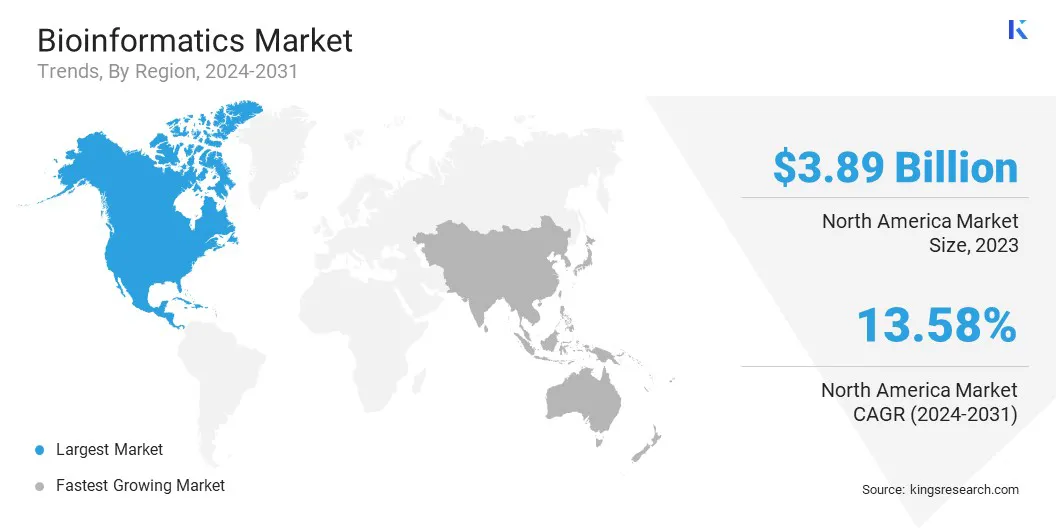enquireNow
Bioinformatics Market
Bioinformatics Market Size, Share, Growth & Industry Analysis, By Product & Services (Bioinformatics Platforms, Bioinformatics Services, Biocontent Management), By Application (Genomics, Chemoinformatics & Drug Design, Proteomics, Transcriptomics, Metabolomics, Others), By Sector Industry, and Regional Analysis, 2024-2031
pages: 120 | baseYear: 2023 | release: January 2025 | author: Omkar R.
Bioinformatics Market Size
The global Bioinformatics Market size was valued at USD 10.42 billion in 2023, and is projected to grow at USD 11.26 billion in 2024 to USD 26.98 billion by 2031, exhibiting at a CAGR of 13.30% from 2024 to 2031.
The market is experiencing steady growth due to increasing research & development activities and the rising occurrence of chronic diseases. Surging demand of personalized medicine is driving the market demand of bioinformatics.
In the scope of work, the report includes service offered by companies such Agilent Technologies Inc., BGI Group, DNAnexus, Inc., Eurofins Scientific, Illumina, Inc., Seven Bridges Genomics, Thermo Fisher Scientific, QIAGEN, NeoGenomics Laboratories, Source BioScience, and others.
The surge in number of government initiatives and programs in hospitals are augmenting the growth of bioinformatics market. Governments across globe are realizing the potential of bioinformatics to improve drug discovery, personalized treatment, and genomic research. These initiatives provide financial, infrastructure, and policy support for research institutions, healthcare providers, and technology innovators.
- In October 2023, the Government of Canada invested USD 15 million their first Pan-Canadian genome library. These type of investments done by the Governments drives research projects, that increases the demand of tools and techniques for data analysis.
Other countries are also initiating programs and genomics projects for bioinformatics for combating public health challenges and rising government initiatives strategies.
Bioinformatics is the branch of biological science that comes from combination of biology and information technology. Streams such as biology, chemistry, computer science, mathematics, and statistics have combined to form a single field. They are essential in the pharmaceutical sector for lead optimization, target identification, and clinical trial design.
Bioinformatics providers must also incorporate regulations and standards. The National Institute of Standards and technology has defining standards to make sure the reliability and accuracy of large-scale biological measurements, that are crucial for biotechnology, precision medicine, and public health fields.
 Analyst’s Review
Analyst’s Review
The bioinformatics market is witnessing rapid growth, driven by advancements in genomics, proteomics, and personalized medicine. Companies in the market are focusing on surging investments in healthcare, information technology, and research & development activities, which fuel the demand for efficient technology in data management within the healthcare sector. Companies are investing in innovative software and data analysis platforms.
- For instance, in July 2023, FOXO Technologies Inc. launched bioinformatics services to advance biotechnology innovation and epigenetic research.
They are utilizing AI & ML to empower the analysis of broad and complex biological datasets. Additionally, key players in the market are collaborating with other companies to enhance their business operations and profits. Many pharmaceutical companies are making significant investments in bioinformatics, as it is widely used in the pharmaceutical industry.
Bioinformatics Market Growth Factors
The growing demand of generic drugs is significantly driving the bioinformatics market growth. These drugs known for their affordability that equivalent to branded medicines. As healthcare shifted towards special treatment that is based on individual genetic data, a demand for bioinformatics tools to interpret and analyze the large amount of genetic data is increasing.
- For instance, in June 2024, Teva Pharmaceuticals has launched U.S. licensed generic of Victoza a 1.8 mg liraglutide injection, used to cure type 2 diabetes, control blood sugar level, and decreases possibility of cardiovascular diseases and strokes.
The rising incidence of chronic diseases find applications in generic drugs. Advanced bioinformatics tools and platforms facilitate the analysis of vast biological data, including genomic sequences, to identify drug targets and optimize formulations.
The market faces challenges related to lack of trained laboratory professionals. Bioinformatics is crucial for precision medicine, including genome sequencing and medication discovery. The wide adoption of next-generation sequencing (NGS) technology and genomics tools has significantly reduced equipment prices, increasing researcher’s accessibility.
Transcriptomic, an essential part of personalized medicine, uses modern bioinformatics techniques to properly interpret gene expression data. The precision and reliability of these analyses depend on the researcher's skill to operate the relevant equipment and interpret the results.
Bioinformatics Industry Trends
Integration of artificial intelligence and machine learning is propelling the bioinformatics market. It allows researchers to analyze broad biological datasets with enhanced accuracy and efficiency, allowing them to make complex decisions about the drug discovery, biological processes, and diagnosis of diseases, and more. It can be utilizing to make predictive models which forecasts biological outcomes such as drug efficacy, protein structure, and disease progression.
- For instance, in July 2023, Genesis Healthcare, a Japanese genetic research and testing company, has launched GenesisGaia, a generative AI platform for genomic data analysis. GenesisGaia is mainly a population genomics platform, using innovative methods to streamline genomic information and address obstacles in pharmaceutical research and development.
The incorporation of artificial intelligence, machine learning, and big data analytics has increased adoption rate of these services.
Growing adoption of next-generation sequencing technologies witness notable shift in molecular diagnostics, genomics research. Next-generation sequencing (NGS) enables high-throughput analysis of genomes, transcriptomes, and epigenomes, offering researchers unmatched insights into the intricacies of genetic codes and gene expression.
This advance technology is revolutionizing genomics research, enabling advancements in molecular diagnostics and personalized medicine, and driving innovation across a wide range of biological and healthcare applications. NGS has transformed understanding of disease mechanisms, genetic variation, and drug responses.
Segmentation Analysis
The global market is segmented based on product & services, application, sector, and geography.
By Product & Services
Based on product & services, the market has been categorized into bioinformatics platforms, bioinformatics services, and biocontent management. The bioinformatics services led the bioinformatics market in 2023, reaching a valuation of USD 4.25 billion. Developments in the genome sequencing methods, like next generation sequencing increased the volume and complexity of genetic data, which increases demand of bioinformatics tools to analyze, process, and interpret data.
- For instance, in March 2022, the Government of Australia invested USD1.1 million to establish Genomics Australia, it assists incorporation of genomic medicine into Australia’s healthcare system.
Rising number of genomic research programs and increasing support from Governments towards these services is contributed for market growth.
By Application
Based on service, the market has been segmented into genomics, chemoinformatics & drug design, proteomics, transcriptomics, metabolomics, and others. The genomics segment captured the largest market share of 29.55% in 2023.
Growing need for genomic data analysis in drug discovery, personalized medicine, and the integration of tools and methods driving segment’s growth. The sequencing technology is utilized in drug development process. Rising genetic testing programs, government’s expenditure, and increasing occurrence of chronic diseases is driving market growth.
By Sector
Based on sector, the market has been categorized into medical biotechnology, animal biotechnology, plant biotechnology, environmental biotechnology, forensic biotechnology, others. The medical biotechnology segment is expected to garner the highest revenue of USD 13.51 billion by 2031.
Bioinformatics used in medical biotechnology for analyze and interpret a complex biological data, which increasing advancements in genomics, proteomics, and transcriptomics. Rising investments in R&D, and growing prevalence of chronic diseases and surging adoption of NGS technologies is drive growth of segment.
Bioinformatics Market Regional Analysis
Based on region, the global market is classified into North America, Europe, Asia-Pacific, MEA, and Latin America.
 The North America bioinformatics market held a notable share of around 37.30% in 2023, with a valuation of USD 3.89 billion. The region has broad presence of research organizations, bioinformatics companies, and academic institutions. Rising investment in research and development and the development of latest and inventive technologies related to genome sequencing and molecular biology driving growth of market in region.
The North America bioinformatics market held a notable share of around 37.30% in 2023, with a valuation of USD 3.89 billion. The region has broad presence of research organizations, bioinformatics companies, and academic institutions. Rising investment in research and development and the development of latest and inventive technologies related to genome sequencing and molecular biology driving growth of market in region.
- For instance, in June 2022, LatchBio, a California-based biotechnology research company, has launched a comprehensive bioinformatics platform targeted at analyzing massive amounts of biotech data and accelerating scientific progress.
Region has high occurrence of genomic and proteomic research studies, and high adoption rate of new healthcare technologies. Research institutes and Governments from the region receive funding from government for development of bioinformatics tools and devices.
Asia-Pacific is anticipated to witness the significant growth at a CAGR of 14.11% over the forecast period. The region has an expanding IT sector and well presence of skilled and trained bioinformatics professionals.
Increasing use of genetic engineering, surge in genomics research, and the expanding biotech and pharmaceutical industry is driving market growth in region. Companies in developing economies such as China, Japan, India and South Korea are receiving Government support and policies. These countries receive Government funding to increase the adoption of bioinformatics solutions.
Competitive Landscape
The global bioinformatics market report will provide valuable insight with an emphasis on the fragmented nature of the industry. Prominent players are focusing on several key business strategies such as partnerships, mergers and acquisitions, product innovations, and joint ventures to expand their product portfolio and increase their market shares across different regions.
Companies are implementing impactful strategic initiatives, such as expanding services, investing in research and development (R&D), establishing new service delivery centers, and optimizing their service delivery processes, which are likely to create new opportunities for market growth.
List of Key Companies in Bioinformatics Market
- Agilent Technologies Inc.
- BGI Group
- DNAnexus, Inc.
- Eurofins Scientific
- Illumina, Inc.
- Seven Bridges Genomics
- Thermo Fisher Scientific
- QIAGEN
- NeoGenomics Laboratories
- Source BioScience
Key Industry Developments
- September 2024 (Launch): Almaden Genomics has launched Data Management and Informatics Services to assist with bioinformatics and computational biology applications.
- February 2024 (Launch): Metabolon, Inc. launched an advanced integrated bioinformatics platform at Biomarkers UK, with the aim of promoting metabolomics analysis in life sciences research. The platform, which focuses on over two decades of experience and a unique library of over 5,400 metabolites, includes revolutionary features such as Pathway Analysis and Biomarker Lenses, allowing for thorough data analysis.
- October 2023 (Launch): BioBam Bioinformatics has launched OmicsBox 3.1, which is designed to assist academics, scientists, and bioinformaticians in advanced omics data analysis and interpretation.
- April 2023 (Partnership): Absci Corp. collaborate with Aster Insights for development of new cancer medicines.
The global bioinformatics market is segmented as:
By Product & Services
- Bioinformatics Platforms
- Sequence Analysis Platforms
- Sequence Manipulation Platforms
- Sequence Alignment Platforms
- Structural and Functional Analysis Platforms
- Others
- Bioinformatics Services
- Sequencing
- Database Management
- Data Analysis
- Others
- Biocontent Management
- Generalized Biocontent
- Specialized Biocontent
By Application
- Genomics
- Chemoinformatics & Drug Design
- Proteomics
- Transcriptomics
- Metabolomics
- Other
By Sector
- Medical Biotechnology
- Animal Biotechnology
- Plant Biotechnology
- Environmental Biotechnology
- Forensic Biotechnology
- Other
By Region
- North America
- U.S.
- Canada
- Mexico
- Europe
- France
- U.K.
- Spain
- Germany
- Italy
- Russia
- Rest of Europe
- Asia-Pacific
- China
- Japan
- India
- South Korea
- Rest of Asia-Pacific
- Middle East & Africa
- GCC
- North Africa
- South Africa
- Rest of Middle East & Africa
- Latin America
- Brazil
- Argentina
- Rest of Latin America
freqAskQues
